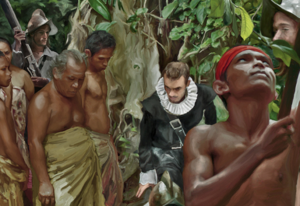The VOC genocide
Nutmeg was a blessing but also a disaster for the population of Banda because they were killed and expelled from their homeland.
Historia, 05 April 2010, By: Hendri F. Isnaeni
On 8 April 1608, Admiral Pieterszoon Verhoeven, with a fleet of thirteen expedition vessels arrived in Banda Neira. The Heeren Zeventien, the VOC board of directors in Amsterdam, gave an order to Amdiral Pieterszoon Verhoeven as written by Frederik Willem Stapel in ‘Geschiedenis van Nederlandsch Indië’: “We ask your attention for the islands where clove and nutmeg grow and we order you to conquer these islands for the VOC, either through negotiation or violence.”
For a long time Banda is known as the main producer of nutmeg (Myristica fragrans) of which the dried flower is called “fuli” [mace]. This flower is covering the nutmeg seed. Since ancient times, nutmeg and fuli were used as spices, which invited Europeans to come.
Once arrived in Banda, Verhoeven found out that the British, under command of Captain William Keeling, had traded with the Bandanese and other Dutch traders. He was not pleased; especially since the Banda people had refused to negotiate with him. Thereafter he went with 300 troops to Naira Island to build Fort Nassau, at the spot of the former Portuguese fortress.
When the Bandanese ‘Orangkaya’ – the local chief or respected figure – saw the construction of the fortress he only wanted to negotiate when the Dutch provided a hostage as guarantee. Verhoeven agreed and appointed two traders named Jan de Molre and Nicolaas de Visscher. The next moment Verhoeven went to the meeting point bringing with him the captain’s council, traders, fully armed troops and the British hostage as prize. However after arriving at the spot of negotiation on the Eastern coast of Naira Island, there was no Orangkaya to be found.

Harvesting Nutmeg [Image: Reiner Lesprenger]
Verhoeven deployed interpreter Adriaan Ilsevier to find the Orangkaya. In a small forest, which is now the mosque of Kampung Baru, Ilsevier found the ‘Orangkaya’s. They were scared upon seeing the fully armed troops so they asked Verhoeven to come only accompanied by a handful of people. Verhoeven then met these ‘Orangkaya’s in the place that is now known as Kampung Verhoeven. It turned out to be a trap. Verhoeven along with trader Jacob van Groenwegen and 26 other Dutch were murdered. Jan Pieterszoon Coen, who was then the secretary of Verhoeven, witnessed the incident.
After the death of Verhoeven, Admiral Simon Janszoon Coen became the new commander. It was him who finished the construction of Fort Nassau.
In 1617 the Heeren Zeventien appointed Jan Pieterzoon Coen as the Governor General. After establishing the VOC headquarters in Batavia, Coen’s aim was to get the monopoly on nutmeg in Banda. Before that the Dutch never succeeded to do so due to their high selling price in comparison to the British or even the locals. Coen was of the opinion that this monopoly could only be gained by expelling and eliminating the local Bandanese from the region.
In 1621 Coen himself led the conquest of Banda Island. He departed with a fleet consisting of thirteen large vessels, a number of reconnaissance boats and forty sailboats and sloops. He brought 1600 Dutch soldiers, 300 Javanese convicts, 100 Japanese samurais, as well as a number of freed slaves. Upon arriving at Fort Nassau, Coen and his forces attacked Lontor Island and manage to conquer the whole island. Selamon village was made into the headquarters. Its village hall became the office of the Bandanese Governor Captain Martin ‘t Sonck. The mosque next to the village hall was turned into accommodation for the soldiers, despite the objection of Jareng, who was the Orangkaya of Selamon.
One night, the hanging lamp inside the mosque fell. Because ‘t Sonck thought that there was an attack, he accused the inhabitants of Lontor of participating. That night, ‘t Sonck deployed his soldiers to chase the fleeing villagers who ran to the forest and the hills. Every villager who got caught was murdered. Their houses and boats were burned or destroyed. The amount of people that managed to escape was about 300 people. They either sought protection by the British or ran to Kei and Aru islands. At least 2.500 people died, either shot, persecuted, or from starvation. From 14.000 Bandanese, only a number of 480 native people remained at Banda island after the massacre.
They also caught the Orangkaya accusing them of being the provocateurs of the riot. Eight of the most influential Orangkaya were put in bamboo cages, built outside Fort Nassau. Six Japanese executioners then went inside and chopped their bodies into 4 pieces. After that they beheaded 36 other Orangkaya and mutilated their bodies. They severed the heads from the bodies and impaled those on bamboo sticks to be shown in public. The massacre of 44 Orangkaya took place on 8 May 1621.
After the native people of the Banda Islands were no longer there, Coen brought in people from other regions to work on this island. Most of them were from Makassar, Buginese, Malay, Javanese, Chinese, some Portuguese, Moluccan, and Butonese. The VOC leased the nutmeg plantations to former soldier and employees of the VOC. The plantation labours were the slaves brought in from all over the archipelago. The harvest was sold to the VOC.
At the site of the massacre there is now the monument Parigi Rante in which the names of 40 Banda fighters and Orangkaya is carved, together with the names of a number of Indonesian freedom fighters which were once exiled to Banda. Such as Tjipto Mangunkusumo, Iwa Kusumasumantri, Hatta, and Sjahrir.
